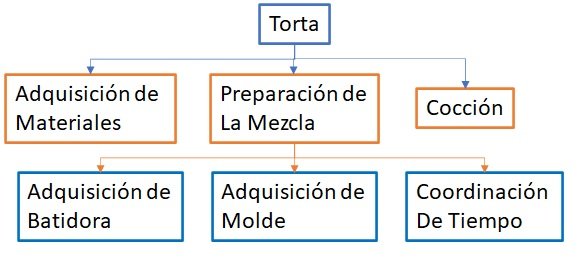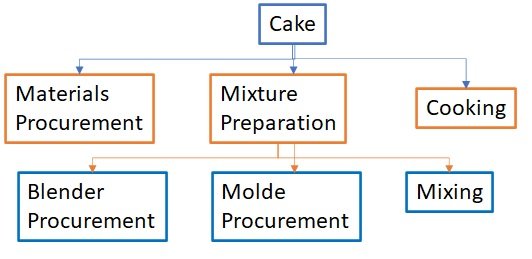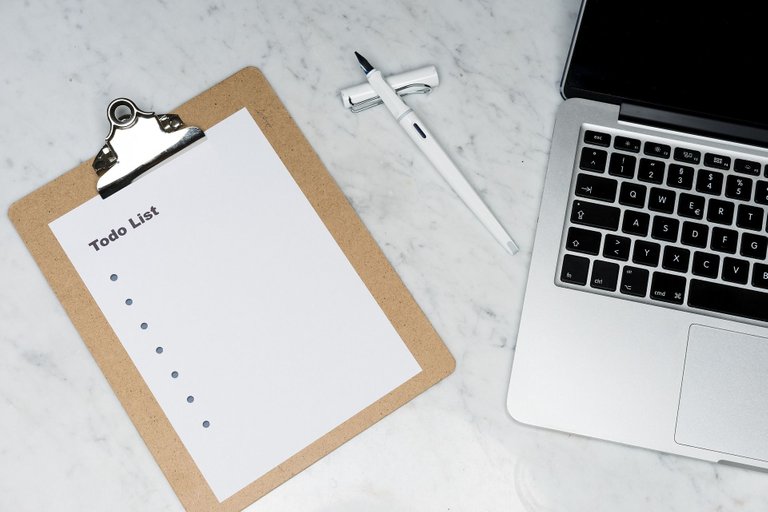Español
Saludos a todos, estamos ahora esquematizando el plan de la etapa pre-operativa para comenzar un emprendimiento. Ya definida las acciones que tenemos que realizar en la etapa pre-operativa (si no haz leído aún, puede hacerlo en este post), debemos convertirlas en tares para poder hacer un plan.
Definición de tareas:
La definición de tareas debe venir de haber seccionado las necesidades de nuestro emprendimiento. Por ejemplo, si vamos a hacer una torta debemos haber pensado previamente en todas las cosas que necesitamos hacer para hacer la torta. Esto pudiera incluir:
• Adquisición de Materiales
• Preparación de la mezcla
• Cocción
De estas acciones se pueden derivar subacciones, por ejemplo, para la preparación de la mezcla se puede necesitar estas acciones:
• Adquisición de batidora
• Adquisición de Molde
• Realización de Mezcla
Podemos seguir definiendo las acciones necesarias con el detalle que amerite… normalmente se hace un gráfico que nos permita visualizar las cosas, de forma que no se nos escape nada. Este proceso de diseccionar las actividades se conoce en la gerencia de proyectos como “Estructura de división del Trabajo” (En inglés “WorkBreakdwonStrucutre”). Una estructura para lo que hemos definido hasta ahora para nuestra torta quedaría como lo siguiente:

En el artículo anterior sobre las metas y acciones, definimos una tabla de acciones con un límite de tiempo. Estas acciones se pueden convertir directamente en una tarea si definimos personal y duración.
Una vez que tenemos todas las acciones que necesitamos desarrollar, debemos definir recursos y duración para convertirlo efectivamente en una tarea que se pueda programar. Debemos pensar en todas las personas, equipos y materiales que necesitamos para llevar a cabo esa tarea, y también debemos establecer cuanto tiempo durará. Para nuestro proyecto de la torta, esto pudiera quedar como sigue
| Tarea | Recursos | Duración |
|---|---|---|
| Adquisición de Materiales | Vehículo | 1 d |
| - | Ingredientes | |
| - | Comprador | |
| Adquisición de Batidora | Vehículo | 0.5 d |
| - | Batidora | |
| - | Comprador | |
| Adquisición de Molde | Vehículo | 0.5 d |
| - | Molde | |
| - | Comprador | |
| Realización de Mezcla | Mesón | 0.5 d |
| - | Implementos | |
| - | Cocinero | |
| Cocción | Cocina | 0.5 d |
| - | Cocinero |
Cómo podemos ver, por cada tarea es muy importante que coloquemos absolutamente todos los factores que intervengan para que la tarea sea ejecutada adecuadamente. Por ejemplo, en las tareas de adquisición, tenemos como equipo el vehículo en el que nos vamos a transportar, los ingredientes que vamos a comprar y la persona que los va a comprar; todos estos elementos son necesarios para ejecutar la tarea, si alguno faltara, la tarea no se podría ejecutar.
En el caso de la tarea de “Realización de Mezcla” tenemos como equipos a utilizar el mesón de la cocina y los Implementos, más el cocinero. Los ingredientes no los tomamos en cuenta porque de eso ya te ocupaste en la tarea de compra. Tú puedes pensar “pero es que ya yo tengo el mesón y los implementos y el cocinero soy yo”, eso está muy bien, ¿pero que pasaría si no tuvieras la cocina disponible y tuvieras que ir a hacerlo a otra parte? ¿Qué pasaría si no tuvieras tiempo tu y tuvieras que pedirle a alguien más que hiciera la mezcla?
Cuando vas a analizar una tarea, no debes pensar en las cosas que tienes o no, tienes que olvidarte de que tienes nada y asumir que todo lo tienes que hacer en otro lado y que debe ser hecho por otra persona. Esto te permite tener 2 previsiones fundamentales para cualquier proyecto. Primero, estarás cubierto en caso de que pase algo contigo o tus cosas y tengas que efectivamente hacerlas afuera, cuando te planificas siempre debes pensar en el peor caso.
En segundo lugar, y más importante, analizar la tarea de esta forma te permite ponerle un costo a tus propias cosas… tu cosas y tu tiempo no son gratis te costaron algo y tu tiempo vale. Si vas a ser cocinero, tiene que ver cuanto cuesta el tiempo de un cocinero y eso será uno de los factores de costos de esa tarea.
No importa que el cocinero seas tú, si lo analizas así, llegado el momento el cocinero puede ser quien sea.
Estos factores, los materiales, equipos y personas se denominan factores de costos. Ellos forman los costos de cada tarea, y de ellos hablaremos en el siguiente artículo donde aprenderemos cómo hacer una planificación una vez definidas las tareas.
Saludos a todos, y nos leemos en el siguiente artículo!
Haz click para llegar a mi perfil...!
English
Greetings to all, we are now outlining the plan of the pre-operational stage to start an enterprise. Already defined the actions that we have to perform in the pre-operative stage (if you have not read it yet, you can do it in this [post] (https://peakd.com/hive-140971/@ibrahimc/etapa-pre-operacional-esp-eng-pre-operational-stage)), we must convert them into tasks to be able to make a plan.
Definition of tasks:
The definition of tasks must come from having sectioned the needs of our enterprise. For example, if we are going to make a cake we must have previously thought about all the things we need to do to make the cake. This may include:
• Materials Procurement
• Preparation of the mixture
• Cooking
From these actions subactions can be derived, for example, for the preparation of the mixture you may need these actions:
• Acquisition of blender
• Acquisition of Molde
• Mixing
We can continue to define the necessary actions with the detail that deserves... Normally a graph is made that allows us to visualize things, so that we do not miss anything. This process of dissecting activities is known in project management as "Work Breakdwon Structure." A structure for what we have defined so far for our cake would be as follows:

In the previous article on goals and actions, we defined a table of actions with a time limit. These actions can be directly converted into a task if we define resources and duration.
Once we have all the actions we need to develop, we must define resources and duration to effectively turn it into a task that can be programmed. We must think about all the people, equipment, and materials we need to accomplish that task, and we must also establish how long it will last. For our cake project, this could look like this.
| Task | Resources | Duration |
|---|---|---|
| Acquisition of Materials | Vehicle | 1 d |
| - | Ingredients | |
| - | Buyer | |
| Acquisition of Blender | Vehicle | 0.5 d |
| - | Blender | |
| - | Buyer | |
| Acquisition of Mold | Vehicle | 0.5 d |
| - | Mold | |
| - | Buyer | |
| Realization of Mixing | Inn | 0.5 d |
| - | Implements | |
| - | Cook | |
| Cooking | Kitchen | 0.5 d |
| - | Cook |
As we can see, for each task it is very important that we place absolutely all the factors involved so that the task is executed properly. For example, in the acquisition tasks, we have as equipment the vehicle in which we are going to transport ourselves, the ingredients we are going to buy and the person who is going to buy them; All these elements are necessary to execute the task, if any were missing, the task could not be executed.
In the case of the task of "Mixing" we have as equipment to use the kitchen counter and the Implements, plus the cook. We do not take the ingredients into account because that is what you already took care of in the task of purchase. You may think "but I already have the counter and the implements and the cook is me", that's fine, but what would happen if you didn't have the kitchen available to cook and you have to go do it somewhere else? What if you didn't have time and have to ask someone else to make the mix?
When you go to analyze a task, you should not think about the things you have or not, you must forget that you have nothing and assume that everything you must do it elsewhere and that it must be done by someone else. This allows you to have 2 fundamental forecasts for any project. First, you will be covered in case something happens to you or your stuff and you have to effectively do them outside, when you plan you should always think about the worst case.
Secondly, and more importantly, analyzing the task in this way allows you to put a cost on your own things... Your stuff and your time are not free, they cost you something and your time is worth. If you are going to be a cooker, you must see how much a cook's time costs and that will be one of the cost factors of that task.
It does not matter that the cooker is you, if you analyze it like this, when the time comes the cook can be whoever he is.
These factors, materials, equipment, and people are called cost factors. They form the costs of each task, and we will talk about them in the next article where we will learn how to make a plan once the tasks are defined.
Greetings to all, and see you in the following article!


Hola @ibrahimc me leí este post como si fuese un vaso con agua y yo sedienta en el desierto. Esto de calcular los costos de un proyecto siempre me ha hecho ruido, por mucho tiempo consideré que las cosas de las que dispongo no deberían entrar en los costos y luego cuando tienes que reponerlas por daño o desgastes te dabas tremendo tortazo.
Aún hoy en día, cuado voy a colocarle valor monetario a mis cursos, me cuesta determinar ciertos costos no perceptibles directamente. Esta idea expresada de manera tan clara ha sido muy reveladora...
"En segundo lugar, y más importante, analizar la tarea de esta forma te permite ponerle un costo a tus propias cosas… tus cosas y tu tiempo no son gratis, te costaron algo y tu tiempo vale. Si vas a ser cocinero, tiene que ver cuanto cuesta el tiempo de un cocinero y eso será uno de los factores de costos de esa tarea." Gracias, gracias.
Que bueno que estamos siendo de utilidad... Estamos a la orden para cualquier otra aclaratoria que tengas tu o quien tu conozcas al respecto.
Me alegro mucho de que le consigas utilidad.
Saludos y gracias por leer!
Congratulations @ibrahimc! You have completed the following achievement on the Hive blockchain And have been rewarded with New badge(s)
Your next target is to reach 4750 upvotes.
You can view your badges on your board and compare yourself to others in the Ranking
If you no longer want to receive notifications, reply to this comment with the word
STOPCheck out our last posts:
Support the HiveBuzz project. Vote for our proposal!
@ibrahimc Esto te permite tener 2 previsiones fundamentales para cualquier proyecto. Primero, estarás cubierto en caso de que pase algo contigo o tus cosas y tengas que efectivamente hacerlas afuera, cuando te planificas siempre debes pensar en el peor caso. Te cuento que este punto me ha salvado la vida en varias oportunidades, cuando facilito talleres en un espacio que no es mio tengo presente todo puede pasar. Soy super precavida. Cuando hago mi lista de recursos que voy a utilizar siempre me paseo por el plan b, ejemplo: llevo una extensión de electricidad aunque me hayan confirmado que en el lugar habra una.
Está muy chevere y super útil esta información que nos traes. Estoy atenta aesta segunda parte donde nos mostrarás desde tu experiencia y mirada cómo hacer una planificación.
Muchas gracias, recibe mi abrazo.
Que bueno que lo encuentras de utilidad... Nos leemos en el artículo que viene 😁